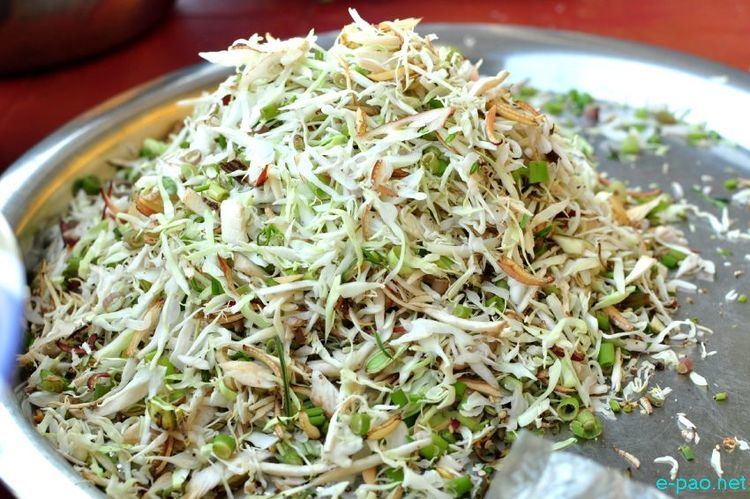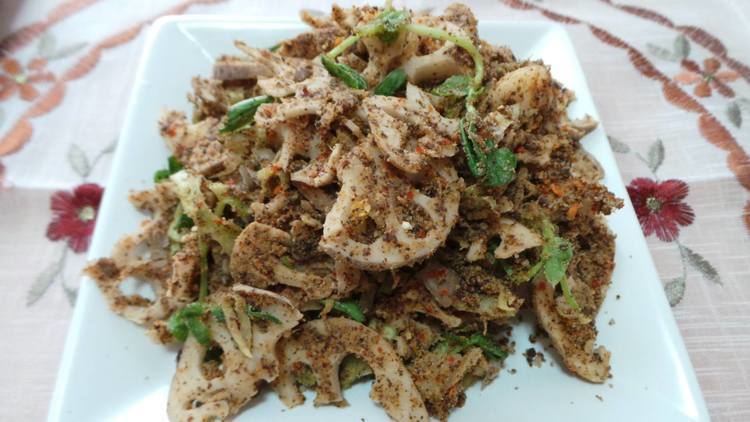Variations seasonal vegetables | ||
Similar Eromba, Fermented fish, Mohinga, Chhena poda, Dried fish | ||
Singju manipuri style salad
Singju (pronounce as sing-zoo) is a typical Manipuri salad-type dish. Its origin takes from Meitei/Meetei Community of Manipur (India) but well eaten by the sibling communities of the state and in some neighbouring states of Northeast India. Singju has been the all-time favourite side dish for meals (other being eromba) and as afternoon or evening snacks too. Meanwhile, eromba should not be confused with singju. Eromba is usually not eaten as snacks while singju is.
Contents
- Singju manipuri style salad
- History
- Preparation
- Veggie Singju
- Non veg Singju
- Some famous Singju Ingredients
- Morok Metpa
- References

Singju has many varieties as much as eromba, because of its seasonal vegetables which are the main ingredients of it. Like eromba, singju is of two types, Veg and Non-veg. The veg type are mainly served at ritual occasions while the non-veg type are eaten at homes.

History

Manipur, being one of the oldest ancient independent kingdoms of East/Southeast/Central Asia, Siberia, Micronesia and Polynesia before being part of India, has lots of varieties of customs and traditions. The word "Singju" comes from the rapid pronunciation of "Manaa-Masing" and "Suba". "Manaa-Masing" means green vegetables and "Suba" means combining. Therefore, in rapid pronunciation the word "Manaa-Masing" drops to "Sing" and the word "Suba" transform to "Ju" for the better pronouncement. As a result, the word, "Singju" was born.
Preparation

Singju being a versetile cuisine i.e. both veg and non veg. There are two different ways to prepare singju cuisine.
Veggie Singju
A veggie singju is mainly served in ritual feasts of the Meitei/Meetei Community of Manipur where they observe at their house courtyard or shrines' yard or community complexes. It can be eaten at homes too but usually people prefer the non veg one at homes.
In this type, the main ingredients are perilla seeds (Thoiding in Meiteilon), chanaa powder, salt, chillies and green leafy vegetables (compatible vegetables' list are listed below and its season).
Non-veg Singju
A non veg singju is mainly eaten at homes and are widely sold in restaurants all over Manipur and in some places of India too. The tag "non-veg" is because of the fermented fish call Ngari use as its ingredient. Because of this, it can not be served in ritual feasts of the community. But if one want to try the real taste of Singju, one better try the non-veg type.
In this type, the main ingredients are Ngari (a manipuri fermented fish), salt, chillies and green leafy vegetables (compatible vegetables' list are listed below and it is seasonal).
Some famous Singju Ingredients
Any vegetables can make a delicious singju. But meanwhile here are some famous ingredients which are being used for making singju. There are, absolutely, some hot delicious vegetable combinations but not all the below vegetables at the same singju.
- Lotus Root (Thambou in Meiteilon)
- Stink Bean (Yongchaak)
- Cabbage (Kobiful)
- Cauliflower (Kobi-Lei)
- Hawai Debi or Tebi
- Hawai Maton
- Unripe Payaya (Awaa Thabi)
- Banana Flower (Laphu Tharo)
- Rice Bean (Chakhawai)
- Onion (Tilhou)
- And much more.
Morok Metpa
Morok Metpa is another singju-alike Manipuri Cuisine. Morok means chilli and Metpa meaning crush. It is traditionally eaten along with daily meals at home but do not serve at rituals. It has both veg and non-veg type. No spices nor oil is being put on it. The ingredients are seasonal.
